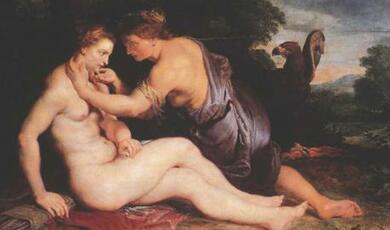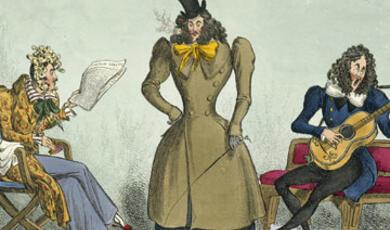Towards a Ministry of Singing
Share
- Details
- Text
- Audio
- Downloads
- Extra Reading
At some time in the fourth century some bishops assembled for a synod in a city whose site is now in Turkey. Today, the place where they met retains little of the grandeur that made it an appropriate choice for such a gathering; there are only broken walls in a coarsened landscape, grazed by sheep, to recall the colonnades and forum of the ancient city with its basilicas. In their deliberations, the bishops identified for the first time in Christian history, an actual ministry of song. They decreed that Only regularly appointed singers capable of reading from parchment, should be allowed to ascend the pulpit from now on and sing in churches. This lecture will build on this foundational moment in Christian musical history.
Download Text
3 November 2016
Towards a Ministry of Singing
Professor Christopher Page
I begin by taking you down the stairs into one of the Roman catacombs, running under the old Via Latina. Some of you have no doubt made a journey like this before, so you know what to expect. The air becomes increasingly cold and dank as we descend, the earth under our feet pressed hard and flat by centuries of pilgrims. The dead have long since been removed from their cold beds, so the cavities in the walls on either side of us are empty. A thin cable feeds a few electric bulbs; the light is feeble, but it saves us from the terrors experienced in the fourth century by St. Jerome when he was still a boy: ‘Here and there’, he recalls, ‘a little light is sufficient to give relief from the horror of darkness, but the very silence fills your soul with dread’.
We are making our way into part of this catacomb that was only discovered in 1911. As we turn, we find before us the painting you see on the first page of your handout. It commemorates a young man named Trebius Justus; he appears at the summit of the picture, seated between his parents as they hold a cloth displaying items of plate, perhaps their offerings to a local church. The lowest stage of the painting emphasizes the family’s prosperity by showing Trebius again inspecting baskets of produce. In the middle range he appears with a codex (a book constructed of a number of sheets of papyrus, or similar materials) bearing text; other materials for reading and writing appear around him and another book drifts to his right, its pages open; there is also a large rectangular chest for books, two pen-cases, a round basket for scrolls.
Today my subject is the rise of a Christian ministry of singing: the formal appointment of one or more people to sing in services of worship, within at least the greater churches, by virtue of their fitness for that task and the common desire to have it done correctly and well. My principal claim is that the charge if singing ministry grew out of an earlier ministry of reading, supported by the skills with writing, reading, grammar and rhetoric that the picture of Trebius Justus celebrates as fundamental pillars of a Roman education. In other words, the roots of Christian singing, viewed as an office, lie with reading and therefore with the emergence of scripture: the corpus of texts to be read. You can see from the picture of Trebius Justus and his parents that rich Christians in Rome were not expected to abandon their wealth, lands and traditions for a life of voluntary poverty; you can also see what the ability to read and write meant to those same wealthy converts whose studies in grammar and rhetoric were as important as precious tableware, their slaves or their fertile estates.
So let us begin with the New Testament and the question of how that canon of texts emerged. As you can imagine, the issue has received a great deal of attention and so has the question of whether any record was made of Christ’s sayings and action within his own lifetime that can now be glimpsed or even reconstructed. The core date to fix in the mind is 200 AD; the verge of the third century. By that time, the sayings of Christ had been circulating in a tradition that was perhaps predominantly oral for the best part of two hundred years; they were continuously repeated and refashioned in the sermons delivered by the president of the worship assembly, or as we would now say, by the priest. The tradition was made and remade in the community’s presence; everything one heard was believed to derive, in a sequence of face-to-face exchanges, from the voices of the apostolic generation and ultimately from the voice of Christ himself. At first, there was no need for a text, and many of the first Christians would probably have agreed with the remark by one early author, who said in a different context: ‘I did not imagine things out of books would help me as much as the utterance of a living and abiding voice’.
Before we go any further, let us hear another kind of ‘living and abiding voice’. Catherine is going to sing the psalm Deus venerunt gentes. ‘O god, the holy temple is defiled; the heathen has laid Jerusalem on heaps’. The psalm will also provide a necessary reminder of the simplest and perhaps the most ancient form of psalmody, recitation on a single pitch with the occasional inflection.
Deus venerunt gentes
For much of the second century, the situation with regards to the emerging gospels, considered as texts, was still fluid. In Rome, about the year 150, the writer commonly known as Justin Martyr refers explicitly to readings from what he calls the ‘memoirs of the apostles’, but those ‘memoirs’ cannot simply be equated with the gospels we know, or with the texts that we possess. Justin cites at least one episode, for example, that is definitely non-canonical: the appearance of fire in the Jordan during Christ’s baptism. He derived it from one of the so-called apocryphal gospels that are not in the New Testament. Justin also received a book known as the apocryphal Acts of Pilate; you won’t find that in your bible either. What is more, the Christian scriptures did not yet exist for Justin as inviolable texts. His citations combine passages that are now in different gospels and often expand them with clarifications; comparison of Justin’s quotations with the received texts of the Matthew, Mark and Luke shows that ten of them are exact, twenty-five are slightly varied and thirty-two are appreciably different. This is in contrast to Justin’s quotations from the standard Greek translation of the Psalms, for example, where his citations are much more consistently exact. It seems he turned to a written text when quoting from the Psalter, but consulted a more fluid and perhaps still partly oral tradition when citing the ‘memoirs of the apostles’, or gospels that were as yet in the making.
Nonetheless, by the end of the second century, towards 200 AD, it becomes possible to discern the nucleus of the New Testament canon. Papyrus fragments begin to reveal that the fourfold gospel we now know was coming to be recognized as a project for scribes to undertake. Hence it is no coincidence that the earliest known reference to an order of readers, called lectores in Latin, appears just after 200, and therefore at the end of the half century when the fourfold gospel canon first comes into view. The emergence of appointed readers is therefore connected with the consolidation of a gospel canon for them to read.
The churches were getting themselves organized in other ways at this date. By the third century, Christians can be found seeking public places of worship, claiming parity polytheists (or pagans, if you prefer). The process is difficult to trace, for there are very few relics of Christian monumental architecture before the fourth century, either in terms of archaeological sites or of inscriptions and literary references. Even in the lifetime of St. Paul, however, the private houses I mentioned in my last lecture were not the only places where Christian worship might take place. The hall where Paul preached in Ephesus represents one kind of interior that a city could offer to a cult, and so does the warehouse on the outskirts of Rome, mentioned in the second-century Acts of Paul as a place where Christians gathered. Old bathhouses, both public and private, also make a sporadic but significant appearance as places adaptable for Christian meetings. The bathhouses had the great advantage of being plumbed in for use as baptisteries, at least in cases where the pipes and the water-source were still viable when Christians began to use them. At least one ancient church in Rome began as an insertion into the large bath-hall of a private house; another bears the revealing name Saint Cyriac in thermis. It begins to seem no coincidence that Justin Martyr, whom I mentioned a moment ago, lodged in Rome above a bathhouse.
By the middle of the third century the readers had a ritual space allotted to them in the church of Carthage. In two of his letters, bishop Cyprian of Carthage (d. 258) twice mentions the reader’s pulpitum, a platform or dais akin to the raised platform for magistrates, orators or judges. ‘There’, writes Cyprian, ‘the reader is easily seen by the brethren’. In another the letter Cyprian compares the reader to a light which will be placed high on a candelabrum, readily seen by all and illuminating the room. ‘Through the conspicuous radiance of his glory he may read the commandments and Gospel of the Lord to all the people’, he writes. Well before Cyprian’s death in 258, therefore, the Christians of Carthage gathered for worship in a place with a (moveable?) fixture for the reader, the pulpitum, which was presumably placed at one end of a space being used as a proto-nave.
I would now like you to hear another chant that probably represents a very early layer of music for Christian worship, the Te Deum. You have the text on your handout. It is an ecstatic hymn of praise, often performed to celebrate a victory, or a miraculous cure at the shrine of a saint. The music is essentially a monotone recitation with formulae to rise onto the recitation tone and to leave it. The Te deum was often performed to the sound of bells, in the Middle Ages, and that is what you will here in this performance which will give the whole text; the whole purpose of this chant, as you will quickly perceive, is to gather and accumulate: ne evocation of divine glory in words and music. This version is from Worcester.
Te Deum laudámus:
Te Dominum confitémur.
Te ætérnum Patrem omnis terra venerátur.
Tibi omnes Angeli; tibi cæli et univérsae potestátes.
Tibi Chérubim et Séraphim incessábili voce proclámant:
Sanctus, Sanctus, Sanctus Dóminus Deus Sábaoth.
Pleni sunt cæli et terra majestátis glóriæ tuæ.
Te gloriósus Apostolórum chorus;
Te Prophetárum laudábilis númerus;
Te Mártyrum candidátus laudat exércitus.
Te per orbem terrárum sancta confitétur Ecclésia:
Patrem imménsæ majestátis;
Venerándum tuum verum et únicum Fílium;
Sanctum quoque Paráclitum Spíritum.
Tu Rex glóriæ, Christe. Tu Patris sempitérnus es Fílius.
Tu ad liberándum susceptúrus hóminem, non horruísti Vírginis úterum.
Tu, devícto mortis acúleo, aperuísti credéntibus regna cælórum.
Tu ad déxteram Dei sedes in glória Patris.
Judex créderis esse ventúrus.
Te ergo quǽsumus tuis fámulis súbveni quos pretióso sánguine redemísti.
Ætérna fac cum sanctis tuis in glória numerári
Salvum fac pópulum tuum, Dómine, et bénedic hæreditáti tuæ.
Et rege eos, et extólle illos usque in ætérnum.
Per síngulos dies benedícimus te.
Et laudámus nomen tuum in sǽculum, et in sǽculum sǽculi.
Dignáre, Dómine, die isto sine peccáto nos custodíre.
Miserére nostri, Dómine, miserére nostri.
Fiat misericórdia tua Dómine super nos quemádmodum sperávimus in te.
In te, Dómine, sperávi:
Non confúndar in ætérnum.
The letters that I quoted earlier reveal that two of the readers in Carthage, named Aurelius and Celerinus, were young men. Aurelius is described as an adolescens and ‘new in years as yet’, in annis adhuc novellis. Celerinus was also appointed while a young man; Cyprian assures his clergy that both he and Aurelius will ‘sit with us hereafter in their advanced and strengthened years’. When we begin to find the epitaphs of readers in Roman churches, as we do in the third century, we learn that many of them were still in boyhood or in early adolescence when they died. Epitaphs from Italy, Spain, Gaul and Africa confirm that many acquired the title of lector within the age range implied by adolescens. The average age of the Roman lectors who died before their twenty-fifth birthday, as revealed by inscriptions, is just fifteen. One was only five, and one might therefore suppose him too young even to have begun his studies with a grammarian, but not too young to have learned to read, especially if he had been set to learn the passage more or less by heart beforehand.
There are few areas of early-Christian life where the continuities between pagan and Christian social attitudes are clearer than they are in the education of children. Both Christian and pagan epitaphs often reveal the fondness with which parents would praise the intellectual accomplishments of their offspring who died too young; they praise a ‘conspicuously educated young man’, honour a boy who was ‘remarkably clever and able in his studies’ or commemorate a youth who was ‘outstanding in learning and wise beyond his years’. The sarcophagus of M. Cornelius Statius, from about 150 AD, reveals the investment of time parents might make in the education of their children, especially of the males who alone could achieve public office. At the far left, Cornelius is breast-fed while the father looks on, holding in his left hand a volumen or scroll to suggest the intellectual contribution he will later make to the child’s development. The father is then shown again, holding his son, followed by a representation of the boy, now much older, driving a small chariot pulled by a goat. In the last scene, the boy declaims his lesson before his seated father. Perhaps it is a passage of Virgil of Cicero. The image with which I began, of Trebius Justus, is the Christian equivalent.
Why was the task of declaiming the most exalted documents of the faith entrusted to boys or young men holding one of the lowest clerical positions? There is one very simple answer. Clergy began their careers at the lowest rung of the clerical hierarchy and then ascended as high as their abilities and patrons would take them. In theory, if not always in practice, this was eventually required throughout the Christian West, and there were obvious advantages to ensuring that the lowest grade of clergy should impose exacting duties of scriptural reading and study upon new entrants. There was no better way to train receptive minds, still of an age to be schooled, than with the weekly task of working through a biblical passage with a teacher, looking to the sense, grammar and meaning in preparation for giving a reading.
But I do not think that can be the whole story. It was also the sound of youthful voices that mattered to the Christian communities. The rulings of early Christian councils sometimes insist that readers should continue to read until the age of puberty but no further, at which time they should either marry or be induced to live in perpetual continence. A recent historian of childhood and early Christianity may be right, I think, to suggest that ‘the extreme youth of certain lectors suggests that it was the child’s voice rather than any reading skills that may have been valued in this context’. The same might be said for the proposal that ‘in the early Church, the holy innocence which Christians nowadays ascribe to choirboys rested on boys who were reading God’s word aloud to their audience’. It was perhaps considered especially appropriate to hear the gospels voiced by a candid and even artless voice that was not darkened, or deepened, by the beginnings of a sexual identity with the onset of puberty. Indeed, a Christian commitment perhaps allowed many parents to hear the voices of their male children, as they read aloud, in a new way. They ceased to hear these boyish voices as a promise of what might be won (parents hoped) in a later life of public office, for which rhetorical skills were essential, and began to hear those sounds as an expressive testimony to what was already possessed and might (parents feared) be all too readily lost: namely a simplicity and innocence expressing the truth of the Church. We sometimes find this inscribed on the readers’ tombs. In the year 384 a reader named Leopardus died aged 14 and was commemorated for his ‘wondrous innocence’; in Gaul a reader named Tigridius, year of death unknown, was remembered as a ‘chaste boy’; another named Severus was a ‘innocent reader’. In sixth century Africa we meet a reader named Castalinus, ‘the little chaste one’, who died at the age of 6.
Did these readers also sing? I think they must often have done so. The use of the term lector to mean a reader-singer, or sometimes perhaps simply a singer, proved remarkably durable in some of the Western churches. In fourth-century Milan, a great church in an imperial capital, it was well understood that ‘some [persons] are more apt for giving readings and some others for psalmody’, in the words of Saint Ambrose, but that great father of the church never uses the terms cantor or psalmista as titles of office in his extensive writings. The singers in his church, one of the most important of the late antique world, were called readers or lectores. Looking around the Mediterranean, we find that a Council convened in 572, in what is now north west Portugal, ruled that no person should ‘sing or read’ (psallere aut legere) from the pulpitum unless they have been ‘ordained a lector’, that is to say a reader. There may also be echoes of the lector’s musical duties in some of the oldest treatises on the grades of clerical office. One of these treatises, in existence by 700, requires the reader ‘to sing the lections’ (lectiones cantare) where the intended meaning of cantare may be musical. It is important to remember here that the custom of regarding the chanting of psalms as a form of liturgical reading lingered for centuries. There may also be traces of musical duties in several of the earliest sacramentaries, books for the celebrant with rites of ordination for various degrees of clergy, including the reader. These may seem dusty documents indeed, but they tell us what we wish to know. In the so-called Missale Francorum, probably of the eighth century in its surviving form, the rite of ordination for a reader calls upon God to make the Church resound with modulis, presumably ‘moduli executed with due care’. The intended sense of moduli may well be musical.
For reasons that will become clear, it is time to hear a chant that goes well beyond a form of monotone recitation to a developed melody; this is the Easter Gradual Haec dies, and I have taken it from a manuscript prepared, early in the twelfth century, for use in the church of the Holy Sepulchre of Jerusalem.
Haec dies
I wanted you to hear a melody, rather than an ornamented form of recitation, because we are now finally on the verge of appointed singers called singers. At some time in the fourth century the bishops of various sees in western Asia Minor gathered for a synod in Laodicea, the metropolitan Church of their province. Today, the site retains little of the grandeur that made it an appropriate choice for such a gathering; there are only broken walls in a coarsened landscape to recall the colonnades and forum of the ancient city with its basilicas, some of which have only recently been unearthed. In their deliberations, as represented by fifty-nine chapters, the bishops strove to keep the doctrine, worship and discipline of the mainstream Church pure. The prelates at Laodicea saw a Church infiltrated by heretics and undermined by the laxity of clergy. It was therefore judged essential to have capable ministers, and in the course of legislating for them the bishops at Laodicea mention the liturgical singer. Christian ministers of ritual singing here make their first appearance here in any surviving Christian document under the title of psaltes, by no means a distinctively. All told, there are six chapters touching upon singers, psalmody and the related issue of liturgical reading. Let just glance at them:
Only ‘regularly appointed’ [or orthodox?] singers, kanonikōn psaltōn, capable of reading from parchment, should be allowed to ascend the pulpit form now on and sing in churches.
Psalms should not be performed one after another but always interspersed with a reading after each psalm.
Singers and readers must not wear the orarion when they read or sing.
Clerics with a ministry of the altar, presbyters and deacons must not attend taverns, nor must the others orders of subdeacon, reader, singer, exorcist, doorkeeper and ascetic.
There should be no delivery of con-canonical or ‘homemade’ psalms in Church, but only of canonical books.
These chapters are succinct in the original and may be no more than the headings for sections of text now lost. They nonetheless suggest how these bishops regarded their singers, how the singers regarded themselves, and how they were to be recruited henceforth from literate men who had passed through some form of induction. For the first time in Christian history, the Laodicea chapters sound the note that becomes so familiar as the centuries pass: singers often lack both discipline and learning, so are constantly to be kept under surveillance.
Chapter XXIII reveals that the singers and readers had ambitions to wear the long stole or orarion widely associated with the deacons. This desire for the vesture of a higher order may owe something to rivalry with the colleges of pagan hymnodists, and it is precisely the concern to be expected in a fourth-century context when many offices, insignia and titles in the late-Roman army and the bureaucracy were being elaborated and redefined. The prelates regarded the psalmists’ desire to wear an item of deacon’s vesture as wholly reprehensible presumptuous and they legislated to suppress it.
The concerning ‘regular’ singers, intercepts the Catholic Church at a crucial moment in its extension of jurisdiction over ritual singing. Henceforth, only ‘canonical singers’ were to be inducted into the office of psalmist. This suggests that singers had sometimes been admitted hitherto on an ad hoc basis without sufficient vetting of their abilities. The bishops at Laodicea therefore insist that candidates should be able to read from parchment (diphthera). There is no hint of an investigation into their reputation for piety or probity, and no apparent scrutiny of their musical abilities. Previously, it seems, singers were selected from a broader constituency that either included illiterates or those accustomed to use cheaper and ephemeral copies of texts on papyrus, forming a continuum with papyrus amulets, prayers, hymns, financial accounts and other administrative documents that create the background noise of literacy in the eastern Mediterranean during the fourth century.
Singers henceforth should be able to construe a written text and divide the words correctly. The texts on parchment, to which the proceedings refer, sound like expensive copies of the scriptures, perhaps to be inspected by the bishops for their textual accuracy, canonicity and orthodoxy. They may even be counterparts to the large and handsome manuscripts of the fourfold gospel and other texts that emerge into view during the fourth century, too costly to be kept anywhere save in the episcopal quarters of the church.
So I end where I began, in the great cemeteries of Rome. Now we begin to find the epitaphs of deacons who were fine singers. These were men of considerable prestige, hence the use of verse in their epitaphs, hardly ever found in the epitaphs of lower orders of lector, acolyte, doorkeeper or gravedigger. One is the epitaph in verse of a Roman deacon named Redemptus, interred in the fourth or fifth century. Finally, we reach a named person, and we even have a sketch of the original inscription, or rather fragments of it. The text calls upon the Christian community of Rome who must be wondering why Redemptus has vanished from their midst; it is because ‘the kingdom of heaven has suddenly snatched him away’.
STRINGE DOLOR LACRIMAS; QVAERIS PLEBS SANCTA REDEMPTVM
LEVITAM? SVBITO RAPVIT SIBI REGIA CAELI.
DVLCIA NECTARIO PROMEBAT MELLA CANENDO
PROPHETAM CELEBRANS PLACIDO MODVLAMINE SENEM.
‘Grief, hold back tears! People of Holy Church, do you seek Redemptus the deacon? The kingdom of heaven has suddenly snatched him away. He put forth sweet honey with nectared singing, celebrating the ancient prophet [King David] with serene music’.
Alleluia: Pascha nostrum
© Professor Christopher Page, 2016
This event was on Thu, 03 Nov 2016
Support Gresham
Gresham College has offered an outstanding education to the public free of charge for over 400 years. Today, Gresham College plays an important role in fostering a love of learning and a greater understanding of ourselves and the world around us. Your donation will help to widen our reach and to broaden our audience, allowing more people to benefit from a high-quality education from some of the brightest minds.


 Login
Login









